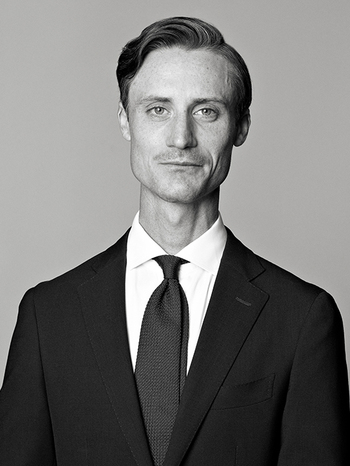Bruno Liljefors
Katt i sommargrönska
Signerad Bruno Liljefors och daterad Qvarnbo -84. Pannå 22 x 15,5 cm.
Proveniens
I arv inom konstnärens familj.
Övrig information
När Bruno Liljefors återvände till Sverige från Frankrike i mitten av 1880-talet slog han sig ned i Kvarnbo utanför Uppsala där han i huvudsak fann motiv till sina tidiga finstämda skildringar av den svenska floran och faunan. Han utvecklades snart till en av sin samtids mest lovande och nyskapande konstnärer. Det är också nu som katten Jeppe kommer in i Liljefors liv. Om deras första möte berättar konstnären i “De vildas rike”:
"Jag kom en gång som ung hem från jakten med en tjäderhöna som jag skjutit. Jag låg inackorderad i en bondstuga. En liten kattunge lekte på golvet dit jag kastade tjäderhönan. Först sprang han som en blixt under sängen men var strax därpå ute igen, gick varsamt fram och tog så resolut tag om halsen på henne och drog den tunga fågeln med sig baklänges in under sängen. Kattungen var just den typ jag tyckte om, jordgrå med mörkare tvärstrimmor och intet vitt. Då jag flyttade fick jag katten som gåva med mig och vi blevo sen oskiljaktiga".
Katten Jeppe blev inte bara Liljefors följeslagare utan också hans bästa vän. Så snart han tog ned bössan från väggen började Jeppe hoppa av glädje för att få följa med ut i vildmarken. När Liljefors varit bortrest mötte Jeppe honom ett par kilometer hemifrån för att ledsaga honom hem. Den gråstrimmiga katten, hans egen Jeppe, blev under årens lopp en berömd modell. Han skildrades antingen som behagligt avslappnad i gröngräset eller ännu hellre som den listige jägaren. Liljefors fotografiska minne hjälpte honom att skildra djuret i rörelse under jakt och flykt. Djurmodellerna sägs ha haft ett instinktivt förtroende för Liljefors då det var dags för avbildning. Han framställde alltid sina modeller som individer och förklarade gärna "Jag målar djurporträtt". Han var också en av de första konstnärerna som lyckades integrera djuren i deras naturliga miljö.
Porträttet av den lilla kattungen, som troligtvis inte är Jeppe, är daterat Qvarnbo -84 och således tillkommet under den period som idag räknas som Bruno Liljefors mest berömda och åtråvärda. Friluftsmåleriet med starka inslag av japonism och fransk impressionism vittnar om tiden i Frankrike. Närkontakten med modellen, sedd ur ett snett grodperspektiv är påtaglig. Den lilla kattungen sitter helt stilla och bevakar konstnären med en intensiv och utforskande blick. Den mjuka pälsens variationer är så realistiska att man frestas sträcka sig in mellan grässtråna för att stryka det mjuka huvudet med handen. Det är en idyllisk bild – men illusorisk då även en ungkatt blixtsnabbt kan slå till mot ett lämpligt byte om tillfälle ges.
Konstnär
Bruno Liljefors är den svenske konstnären som förknippas med natur- och djurmotiv, särskilt i dramatiska situationer. Liljefors konstnärliga bana startade med studier vid Konstakademin 1879, och fortsatte 1882 i Düsseldorf där studierna kretsade kring djurmåleri. Därefter gick resan vidare till Venedig, Rom, Neapel, Paris och Grez. Väl återkommen till Sverige började han teckna och måla djur, särskilt katter och småfåglar i litet formatet, från början i intimt samspel med naturen. Han övergick sedan till bredare skildringar av vilda djur och natur, av havsutsikter med sjöfågel och av dramatiska scener med kamp mellan rovfåglar och olika villebråd.
Liljefors betraktas som vårt lands främste djurmålare med en mycket stor produktion, men han var även verksam som skulptör och en ivrig jägare. Liljefors skildrade, i motsats till det samtida "idylliska" djurmåleriet, djurens vardag med fokus på rörelse, anatomi och deras anpassning till landskapet. Det är här som storheten i hans måleri ligger, i förmågan att med stor skärpa visa djuren i dess rätta miljö. Detta har han ibland uppnått genom jakt och observation av levande, men i vissa fall också döda djur. Kända konstverk är målningarna "Rävfamilj" (1886) och "Havsörnar" (1897), samt skulpturen "Lek" (1930) vid Stockholms Stadion. Han utförde även fondmålningarna till det konstgjorda landskapet vid Biologiska Museet i Stockholm invigt 1893. En mer okänd sida av Bruno Liljefors är hans karriär som varietéartist och elitgymnast med barr som specialitet. Liljefors är främst representerad på Nationalmuseum, Waldemarsudde och Thielska galleriet i Stockholm.








































